Marketing Funnel Explained for Modern Growth
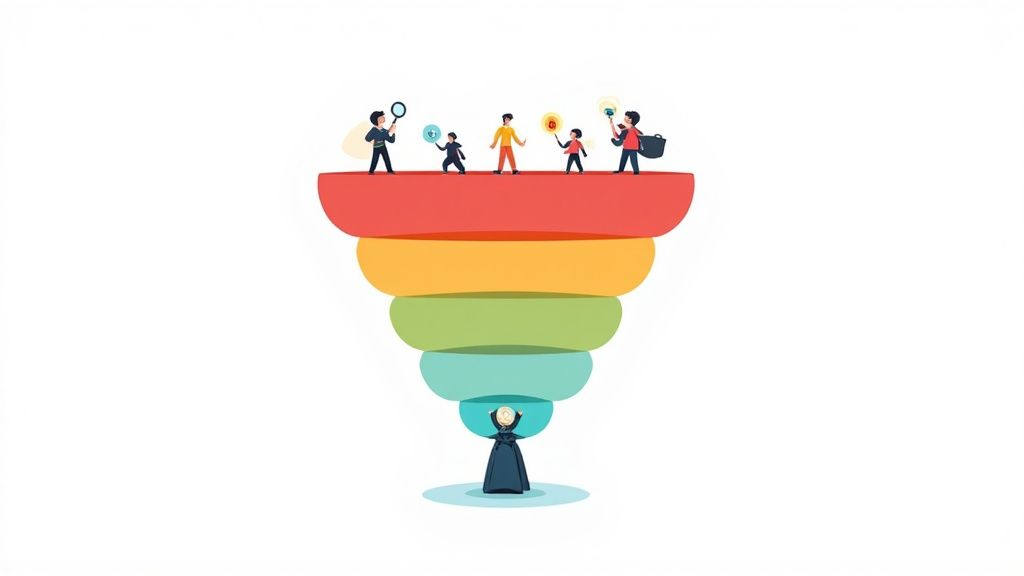
Let's get one thing straight: a marketing funnel isn't some abstract business school concept. Think of it as the strategic roadmap you build to guide a complete stranger on a journey, turning them into a loyal, paying customer.
It’s a visual way to understand the path people take, starting from the very first time they hear your brand's name all the way through to the moment they click "buy." Mastering this is the key to attracting, engaging, and converting your audience without just guessing what works.
What Is a Marketing Funnel and Why It Matters
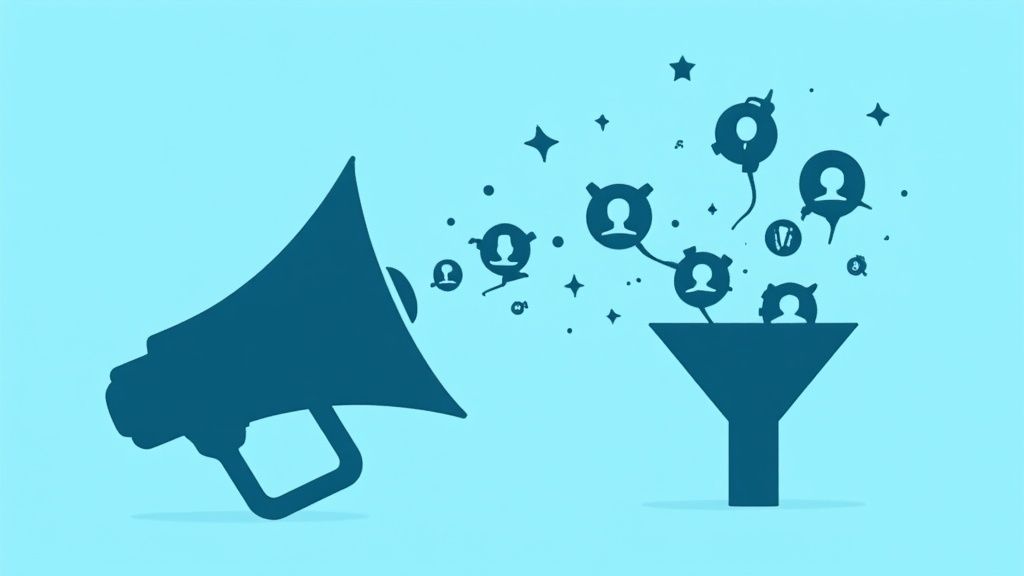
Imagine trying to navigate a huge, chaotic market without a map. You’d probably wander around, miss all the best stalls, and maybe even leave empty-handed. A marketing funnel is that map for your business. It creates a clear, predictable path for potential customers to follow.
Instead of just throwing random marketing tactics at the wall and hoping something sticks, the funnel gives you a solid framework. It breaks the customer's journey down into clear, manageable stages, each with its own goal. This structured approach is what separates haphazard marketing from a deliberate, revenue-driving machine.
The Strategic Value of a Funnel
Getting your head around the marketing funnel is a game-changer. It shifts your entire perspective from chasing short-term wins to building a long-term strategy that actually works.
It also lets you diagnose problems with surgical precision. Are you getting tons of website traffic but almost no sales? The funnel helps you pinpoint the exact "leak" between the top and bottom stages.
By mapping this journey, you unlock critical insights that lead to much smarter business decisions. Specifically, a well-defined funnel helps you:
- Allocate Resources Effectively: You can see exactly which marketing channels and content types work best at each stage, making sure your budget and effort go where they'll have the most impact.
- Improve the Customer Experience: When you understand what your customer is thinking at each phase, you can deliver the right message at exactly the right time. This builds trust and rapport like nothing else.
- Create Predictable Growth: A functional funnel turns growth from a guessing game into a measurable system. You can start forecasting sales based on how many leads are entering the top.
A well-structured funnel isn't just about making a sale; it's about building a relationship. It guides prospects through a logical progression, answering their questions and easing their concerns until they feel confident and ready to become a customer.
From Chaos to Cohesion
Without a funnel, marketing can feel like a jumbled mess of disconnected activities—a blog post here, a social media ad there. There's no clear line connecting your efforts to the ultimate goal of making money. This chaos almost always leads to wasted time and budget on things that don't move the needle.
A marketing funnel, explained simply, is the bridge that connects initial brand discovery to the final purchase. It forces you to think about the entire customer lifecycle, making sure every piece of content and every campaign has a specific job to do. This holistic view turns disconnected tactics into a cohesive strategy that nurtures leads from awareness to advocacy, creating a sustainable engine for your growth.
Mapping The Four Core Stages Of The Customer Journey
To really get a handle on how a marketing funnel works, you have to break it down into its core stages. But don't just think of them as steps in a process. Think of them as different mindsets a potential customer is in. Each phase demands a completely different approach, message, and set of tools to actually work.
Walking through this journey stage-by-stage is what turns the funnel from a pretty diagram into a practical, actionable playbook. You’ll learn how to meet your audience where they are, give them exactly what they need at the right time, and gently guide them toward becoming a valued customer.
Stage 1: The Awareness Stage
This is the very top of your funnel, often called ToFu (Top of Funnel), and its goal is simple: get noticed. At this point, your target audience might not even know your brand exists. They probably only have a vague idea of a problem they're facing and are definitely not thinking about buying anything yet.
Your job here isn't to sell. It's to educate, entertain, and attract. The content you create should be broad, genuinely helpful, and easy to find. You're casting a wide net to grab the attention of anyone who could be a great fit for your product later on. It’s all about becoming a familiar, trusted voice in your space.
H3: Effective Channels And Tactics For Awareness
- Search Engine Optimization (SEO): This is all about creating blog posts and articles that answer the common questions your audience is typing into Google. For instance, a project management software company might write a killer article on "How to Improve Team Collaboration Remotely."
- Social Media Marketing: You need to be sharing engaging, valuable content—think infographics, short videos, and quick tips—on the platforms where your ideal customers actually hang out.
- Paid Advertising: Running targeted ads on platforms like Facebook or Google can get you in front of a broad but relevant audience that fits your customer profile.
The key here is to offer value with zero strings attached. You're planting the seeds of trust that will pay off big time in the later stages.
Stage 2: The Interest And Consideration Stage
Once you've caught someone's attention, they slide into the middle of the funnel (MoFu). This is where they go from being passively aware to actively interested. They've put a name to their problem and are now digging in, researching potential solutions. This is the critical evaluation phase where they start comparing their options.
Now, your content needs to shift gears. You move from broad educational pieces to more specific, solution-focused materials. You're no longer just a helpful resource; you're a serious contender to solve their problem. The goal is to nurture that budding relationship, build credibility, and show them why you're the best choice. To really get this part right, it's essential to master the customer journey funnel.
This stage is all about building trust. You've earned a moment of their attention; now you must prove you understand their specific challenges and have the expertise to solve them. This is where you separate your brand from the competition.
This diagram shows how different marketing channels come into play as you build interest.
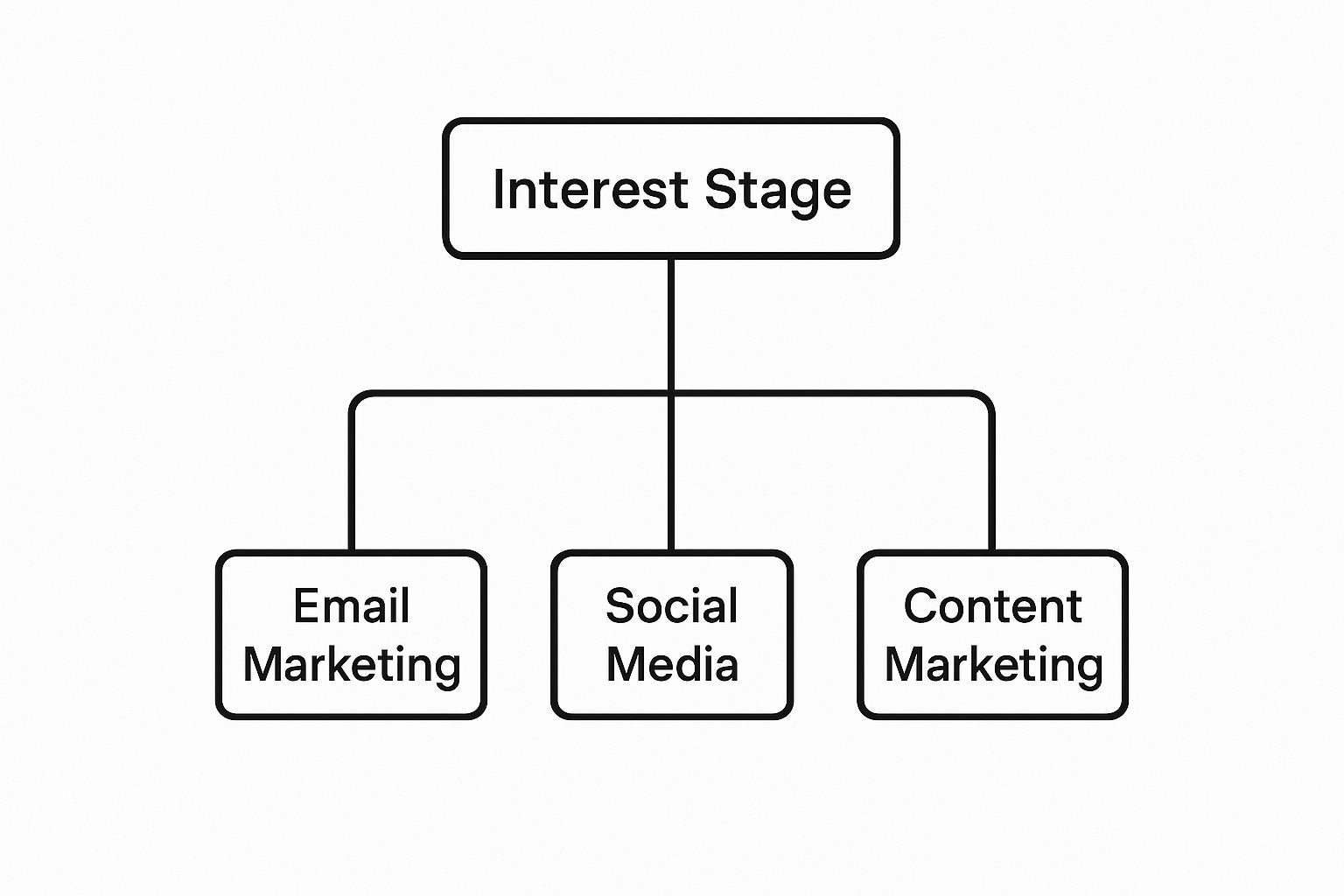
As you can see, nurturing interest isn't a one-trick pony. It requires a smart mix of direct communication, community engagement, and in-depth content.
To help you visualize this, here's a quick breakdown of how marketing channels map to each stage of the funnel.
Marketing Funnel Stages And Corresponding Channels
This table provides a clear summary of each funnel stage, its primary goal, and the most effective marketing channels and tactics to use at that point in the customer journey.
| Funnel Stage | Primary Goal | Key Channels & Tactics |
|---|---|---|
| Awareness (ToFu) | Attract a broad audience and introduce your brand. | SEO (Blog Posts, Articles), Social Media, Paid Ads (Google, Facebook), Public Relations. |
| Interest & Consideration (MoFu) | Nurture leads, build trust, and showcase expertise. | Email Marketing (Newsletters, Drip Campaigns), Webinars, Case Studies, Ebooks, Retargeting Ads. |
| Conversion (BoFu) | Persuade qualified leads to make a purchase. | Free Trials, Product Demos, Testimonials, Special Offers & Discounts, Clear CTAs. |
| Loyalty & Advocacy | Retain customers and turn them into brand promoters. | Loyalty Programs, Customer Support, Personalized Emails, Surveys, Community Forums. |
Using the right channels at the right time is what transforms a casual browser into a loyal advocate for your brand.
Stage 3: The Conversion Stage
Welcome to the bottom of the funnel (BoFu). Your prospect has done their homework, they trust your brand, and they're right on the edge of making a decision. This is the moment of truth where a well-nurtured lead becomes a paying customer. Everything you've done so far has led to this point.
Here, your focus shifts entirely. You need to make the decision to buy as easy and compelling as possible. Your messaging gets hyper-specific, zeroing in on the direct benefits, value, and outcomes of your product. Your mission is to remove any final hesitation and give them a clear, irresistible reason to act now.
Proven Tactics For The Conversion Stage
- Compelling Offers: Limited-time discounts, special bundles, or exclusive bonuses can create a sense of urgency and provide that final nudge they need.
- Product Demos and Free Trials: Letting people experience the product firsthand is one of the most powerful conversion tools out there. It completely removes their uncertainty.
- Customer Testimonials and Case Studies: Nothing sells like success. Showcasing stories from happy customers provides powerful social proof and builds massive confidence in the purchase.
- Clear Calls-to-Action (CTAs): Use direct, action-oriented language. "Buy Now," "Get Started Today," or "Claim Your Discount" leaves absolutely no room for confusion.
And please, don't forget a seamless checkout process. A clunky, complicated, or slow payment system can make even the most excited leads abandon their cart at the last second. It's a non-negotiable.
Stage 4: The Loyalty And Advocacy Stage
The journey isn't over when the payment goes through. The smartest businesses know that keeping an existing customer is far cheaper and more effective than finding a new one. This final stage is all about turning that one-time buyer into a loyal, repeat customer—and, if you play your cards right, a vocal brand advocate.
The goal is to deliver an outstanding post-purchase experience that makes them feel great about their decision. This is where you build the long-term relationships that drive steady revenue and organic growth through word-of-mouth.
Excellent customer support, personalized follow-ups, and loyalty programs are your best friends here. When customers feel truly appreciated, they don't just come back; they tell their friends. And just like that, they start feeding new prospects right back into the top of your funnel.
Tracking the Metrics That Actually Drive Growth
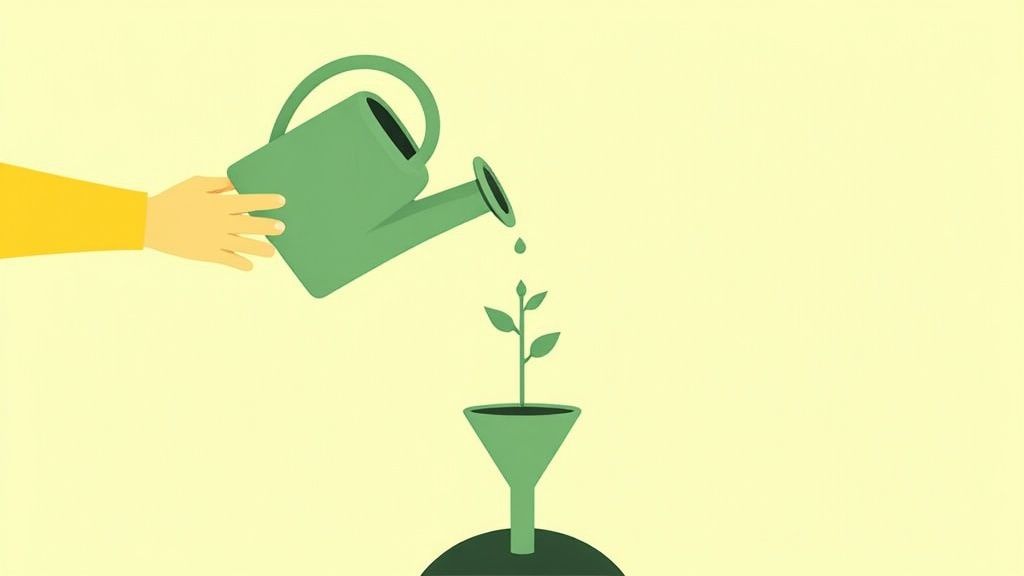
A marketing funnel is only as good as your ability to measure it. Without the right data, you're flying blind, hoping for the best while your budget quietly leaks away.
The trick is to ignore the vanity metrics that feel good but mean nothing. We need to focus on the key performance indicators (KPIs) that connect the dots between your marketing activities and real business results.
Think of it like a doctor checking a patient's vital signs. Follower counts are nice, but they don't tell you if your business is healthy. You need to measure what matters at every single stage.
Top of Funnel Metrics: Awareness
Up here at the top of the funnel (ToFu), the game is all about casting a wide net to attract a relevant audience. Impressions might seem like a big deal, but they're mostly noise. Instead, we want to see signs of genuine, initial engagement.
Here’s what to watch:
- Website Traffic: This is your foundation. Are your blog posts and social media efforts actually pulling people to your site? Look beyond overall sessions and drill down into unique visitors to see how many new people you're reaching.
- Traffic Sources: Where is everyone coming from? Knowing if your audience finds you through organic search, social media, or referrals tells you exactly which channels are pulling their weight and where to double down.
- Social Media Reach: Forget likes. Look at reach (how many unique people see your content) and especially shares. A share is a powerful endorsement—someone found your content so valuable they put their own reputation behind it.
Middle of Funnel Metrics: Consideration
Once you’ve got their attention, the focus shifts. As prospects move into the middle of the funnel (MoFu), you need to build a relationship and prove your worth. The metrics here tell you who's just browsing and who's starting to get serious.
The middle of the funnel is where trust is forged. Your metrics should reflect this, moving beyond simple views to measure actions that indicate a prospect is seriously evaluating your solution.
These engagement metrics tell the real story:
- Click-Through Rate (CTR): Whether it's an email or a social ad, a strong CTR means your message is compelling enough to make someone stop scrolling and take action.
- Time on Page: Are people actually reading that in-depth guide you wrote, or are they bouncing after a few seconds? Longer average time on page is a great sign that your content is hitting the mark.
- Lead Magnet Downloads: This is a big one. When someone trusts you with their email address for an ebook or webinar, they're raising their hand and showing real interest. The conversion rate on these landing pages is a critical MoFu metric.
For a deeper look at this, our guide on https://www.lumeo.me/en/blog/measuring-content-performance breaks down exactly how to track these essential middle-funnel interactions.
Bottom of Funnel Metrics: Conversion
This is where your hard work pays off—literally. At the bottom of the funnel (BoFu), the metrics are all about the hard numbers that drive revenue. These are the KPIs that get your leadership team's attention.
A core metric for any paid campaign is the customer acquisition cost calculation, which shows how efficiently you're turning ad spend into customers.
Beyond that, you absolutely must track:
- Conversion Rate: The ultimate test of your funnel's effectiveness. What percentage of the leads who enter your orbit actually become paying customers?
- Customer Lifetime Value (CLV): How much is a customer really worth to you over time? A high CLV means you can afford to spend more to acquire them, out-maneuvering your competition.
- Sales Cycle Length: How long does it take to go from "hello" to a closed deal? Shortening this cycle can have a massive impact on your cash flow and overall growth.
Finally, the most powerful diagnostic tool you have is the stage-to-stage drop-off rate. By calculating the percentage of people who disappear between Awareness and Consideration, or between Consideration and Conversion, you can pinpoint the biggest leaks in your funnel. This tells you exactly where to focus your energy for the biggest returns.
How Your Acquisition Channels Shape Funnel Success
Here’s one of the most important lessons in marketing: not all website traffic is created equal. The channel a person uses to find you—whether it's an organic search, a social media ad, or a friend's recommendation—powerfully shapes their entire journey. Where your leads come from directly impacts how they behave, how quickly they come to trust you, and ultimately, whether they buy anything.
Think about two potential customers for a moment. The first one finds your website by searching Google for "best software for project management," a query loaded with intent. The second person is just scrolling through their Instagram feed and casually clicks on a slick-looking ad.
That difference in initial intent is massive. The Google searcher already has a problem they are actively trying to solve; they're probably in the Consideration stage. The social media visitor is just curious, barely entering the Awareness stage. Trying to treat them the same is a recipe for a leaky funnel and wasted ad spend.
High Intent vs. Low Intent Channels
Once you grasp the built-in intent of each acquisition channel, you can start tailoring your strategy. This lets you set more realistic goals, follow up more effectively, and spend your budget a whole lot smarter. It's a simple fact that some channels naturally deliver more qualified, ready-to-buy leads.
Let's break down the typical mindset of leads from different sources:
- Organic Search (SEO): Visitors coming from search engines are usually on a mission. They have a specific problem or question, which makes them highly qualified and much more likely to move through the funnel quickly.
- Referrals: When someone is referred by a friend or colleague, they show up with a pre-installed layer of trust. These are often the warmest leads you can get because that trust has been transferred from a source they already know.
- Social Media Ads: Traffic from platforms like Facebook or TikTok is usually interruption-based. You’re catching people in their downtime. Their initial intent to buy is low, and they will almost certainly need a much longer nurturing cycle to build interest.
The real key to an efficient funnel is shifting your focus from a volume-based mindset ("How many leads did we get?") to a value-based one ("Which channels brought us the most profitable customers?").
The Impact on Conversion Rates
A lead's origin doesn't just affect their journey—it has a direct, measurable impact on your conversion rates. The data consistently shows that leads from high-intent or high-trust channels convert at a significantly higher clip. Just look at the success rates of sales calls; there's a clear pecking order based on where the lead came from.
Reported sales call conversion rates show a dramatic difference. Referral leads are the clear winner, converting at a 25.56% rate. They're followed by email marketing at 22.83% and SEO at 21.22%. This just goes to show how trust and intent translate directly into sales. You can dig into more data on how acquisition methods influence sales in this detailed breakdown of conversion rates by industry on focus-digital.co.
Matching Your Strategy to the Channel
When you start recognizing these differences, you can finally ditch the one-size-fits-all approach. Instead, you build specific pathways that guide leads from different channels more effectively. For example, a lead who clicked a broad awareness ad might be perfect for a slow-drip, educational email sequence.
On the other hand, a lead who found you via organic search and downloaded a detailed comparison guide is signaling they're much further along. They could be fast-tracked straight to a product demo invitation.
This strategic alignment is what turns a good marketing funnel into a great one. For a deeper dive into this, check out our guide on how to generate leads with channel-specific tactics. Matching the channel, the message, and the funnel stage is how you maximize your return on investment and build a truly profitable customer base.
Actionable Strategies for Optimizing Your Funnel
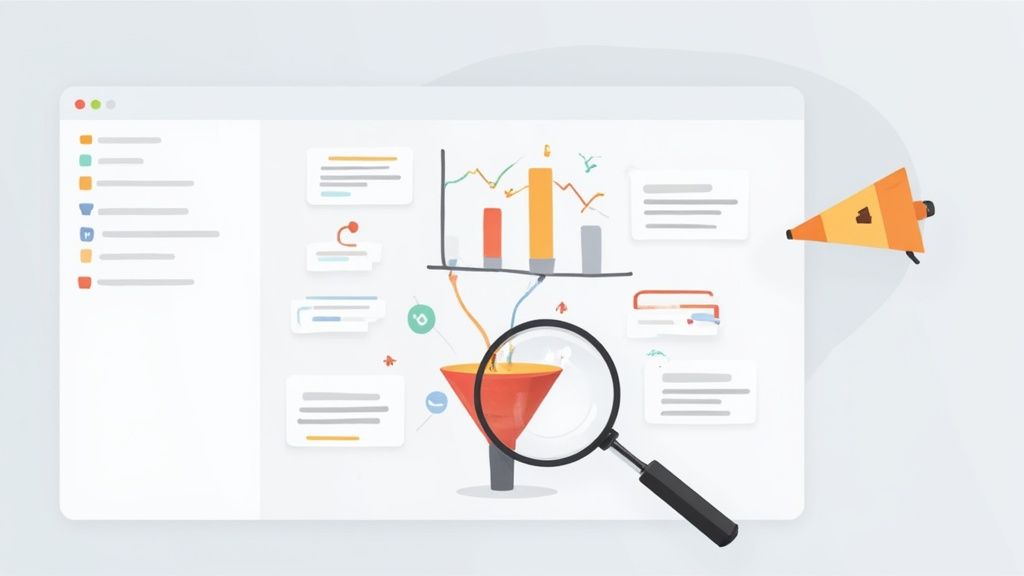
Knowing what your marketing funnel looks like is one thing, but actually improving it? That’s where the real growth is hiding. Optimization isn’t a one-and-done project. It’s a continuous process of making small, smart, data-backed tweaks that plug the leaks and make the journey smoother for your customers.
Picture your funnel as a series of pipes. A few small leaks here and there might not seem like a big deal, but they add up, and you lose a ton of pressure by the end. By testing and tightening each connection point, you ensure more of those valuable leads you worked so hard to get actually become happy customers.
This isn't just about rearranging things; it's about turning your funnel from a static map into a high-performance engine that drives your business forward. You’re taking what you’ve learned and turning it into real actions that boost engagement, sales, and loyalty.
Pinpointing Your Biggest Opportunities
Before you start changing everything, you need to figure out where your efforts will make the biggest splash. The secret is using your metrics to find the biggest drop-off points. Is your landing page getting a ton of traffic but almost no sign-ups? Bingo. That's your starting line.
Here are a few of the most common—and impactful—places to start digging for gold:
- A/B Testing Key Assets: Don't just guess what works. Systematically test different versions of your landing page headlines, button colors, and calls-to-action (CTAs). Even a tiny lift in your conversion rate at this stage can create massive ripples all the way down the funnel.
- Simplifying Critical Processes: Make signing up or checking out so easy it’s almost effortless. Every extra field you can delete from a form or step you can cut from the checkout process is one less reason for a potential customer to get frustrated and leave.
- Crafting Retargeting Campaigns: Don’t just wave goodbye to interested visitors. Use retargeting ads on platforms like Google or Facebook to bring back people who checked out specific pages but didn't convert. It's a simple way to remind them of the value you offer and give them another chance to say yes.
Aligning Marketing and Sales for a Seamless Handoff
One of the biggest leaks in any funnel happens right at the handoff from marketing to sales. A lead who has been carefully warmed up with helpful content can be instantly turned off by an aggressive or out-of-sync sales pitch. Keeping your messaging consistent is non-negotiable.
This alignment isn’t just some fluffy team-building exercise; it directly impacts your revenue. In fact, research shows that companies with tightly synced sales and marketing teams see conversion rates up to 67% higher than those who don't. A key metric to watch here is your MQL-to-SQL conversion rate. If marketing generates 500 MQLs and sales qualifies 150 of them as SQLs, you’ve got a 30% conversion rate at that crucial handoff. For a deeper dive, check out these essential sales funnel metrics on dashly.io.
A truly optimized funnel feels like one continuous conversation to the customer. The jump from a marketing email to a sales call should be so smooth they barely notice they've switched departments.
An Example of Optimization in Action
Let's say an e-commerce brand notices a classic problem: lots of people add products to their cart but never actually buy them. Instead of just writing this off, they decide to optimize their email sequence for abandoned carts.
Their old strategy was just a single, generic "You left something behind!" email. That's it.
Their new, optimized approach is a three-part automated series:
- Email 1 (2 hours later): A friendly, low-pressure reminder with a picture of the items still in the cart. The tone is more "Did you forget something?" than "Buy this now!"
- Email 2 (24 hours later): This email shares customer testimonials or reviews related to the specific products in their cart. It’s all about building social proof and reinforcing their great choice.
- Email 3 (48 hours later): A final nudge that offers a small, time-sensitive discount, like 10% off, to create a little urgency and close the deal.
This simple, strategic tweak—a small but consistent improvement—could easily boost their cart recovery rate by several percentage points. That's the heart of funnel optimization: finding those small changes that lead to major gains.
Adapting the Funnel for High-Value Sales Cycles
Let’s be honest. The classic marketing funnel you see everywhere—the one built for quick e-commerce buys—just doesn't cut it for high-ticket industries. If you're selling complex B2B software, luxury real estate, or high-end consulting services, the customer journey isn't a simple slide. It's a marathon.
Trying to apply that standard model is a recipe for frustration because it completely misses the long sales cycles and deep consideration these purchases demand. A quick conversion is the last thing on your prospect's mind. Your focus has to shift from chasing immediate sales to methodically building relationships and nurturing leads over the long haul. When a six-figure decision is on the table, trust isn't built overnight.
The Consideration Stage Becomes the Main Event
For high-value sales, the middle of the funnel—the Consideration stage—isn't just a step; it's the heart of your entire strategy. This is where potential clients live for months, not minutes, as they weigh their options. Your job is to become their most trusted advisor by providing a steady stream of deep, valuable content that positions your brand as the undeniable expert in the field.
This means your content arsenal needs a serious upgrade. Forget the quick-hit blog posts. To win here, you have to master the art of a B2B content marketing strategy that educates, reassures, and builds confidence at every turn.
Here’s what works in this extended consideration phase:
- In-depth Whitepapers: Show you’ve done the research and can solve their most complex problems.
- Personalized Demos: A one-on-one walkthrough tailored to a prospect’s specific pain points is incredibly persuasive.
- Expert Consultations: Offering direct access to your specialists provides immense value and forges a powerful personal connection.
- Detailed Case Studies: Nothing builds confidence like showing proven results with clients just like them. This is the social proof they need to justify a major investment.
Redefining Conversion and Measuring Success
When a sales cycle stretches across months or even a year, how do you define a "conversion"? You have to change the scorecard. Instead of fixating only on the final signed contract, you need to track the series of smaller commitments—or micro-conversions—that signal a prospect is moving deeper into the journey with you.
In a long sales cycle, every small step forward is a victory. The goal is to measure engagement and trust-building over time, recognizing that the final purchase is the result of many smaller 'yeses' along the way.
These touchpoints become your new, more meaningful KPIs. Instead of just looking at closed deals, you start measuring things like:
- Demo Requests: This is a clear signal of high interest and a willingness to invest time.
- Whitepaper Downloads: It shows the prospect is actively researching and views you as a credible source.
- Proposal Submissions: This is a huge milestone, proving the lead has moved from evaluation to serious buying intent.
This shift in measurement is critical because conversion rates for high-value items are naturally much lower and slower. One industry-wide survey found the average conversion rate across various sectors was about 2.9%. But for industries with bigger price tags, like real estate or automotive, those rates often dip even lower, which makes perfect sense given the longer journey. You can find more data on conversion rate benchmarks on ruleranalytics.com.
By adapting your funnel this way, you’re aligning your strategy with the real-world process of how big decisions are made. You turn a complex, winding path into a predictable and profitable roadmap.
Turn your professional content into visually stunning, engaging carousels with Lumeo. Our AI-powered platform makes it simple to create high-impact visual assets that boost your online presence and drive growth. Start for free at Lumeo.